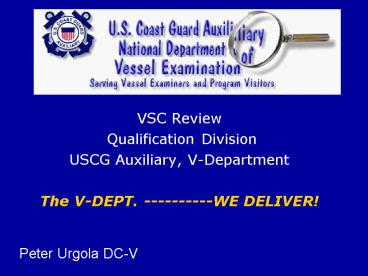VSC Review - PowerPoint PPT Presentation
1 / 23
Title:
VSC Review
Description:
Recreational boats less than 16 feet on coastal waters or the Great Lakes need ... boats operating on non-coastal waters should have. some means of making a ... – PowerPoint PPT presentation
Number of Views:70
Avg rating:3.0/5.0
Title: VSC Review
1
- VSC Review
- Qualification Division
- USCG Auxiliary, V-Department
- The V-DEPT. ----------WE DELIVER!
Peter Urgola DC-V
2
Vessel Safety Check Reminders
3
Flotation Devices (Life Jacket)
- For Personal Watercraft
- operators, many states
- require that the Life Jacket be worn and they may
also require that the Life Jacket - have an impact rating.
4
Flotation Devices (100 MPH Life Jacket)
- WARNING
- 100 MPH rated Life jackets
- do not protect wearers from
- traumatic injury in a high
- speed crash.
- The impact rating means
- that the Life jacket still be buoyant following a
100 MPH impact.
5
Flotation DevicesNon-Serviceable and Substandard
Type I Unicellular Plastic Foam Life Preservers
- The US Coast Guard strongly recommends
- That owners and operators carefully inspect
- all of their older Type I unicellular plastic
- foam Life Jackets.
- Potential indications that a Type I unicellular
- plastic foam Life jacket may no longer be
serviceable include
6
Flotation Devices
- Compression The Life Jacket may be compressed
from many years of stowage. - 2. Loss of resiliency The Life Jacket is
excessively hard, stiff or its foam is brittle.
Normally after - compressing the Life Jacket to about half
its initial thickness, the foam should expand to
its original dimension in a short period of time.
7
Flotation Devices
Compression
Loss of resiliency
8
Flotation Devices
- 3. Shrinkage A physical reduction in size may be
indicated by wrinkling of the coating on vinyl
dipped type or by a loose fitting shell on a
fabric-covered Life Jacket. - Questions regarding this information may be
addressed to Mr. Marty Jackson, Staff Engineer of
the U.S. Coast Guard Headquarters Lifesaving
Fire Safety Standards Division at (202) 267.0710
or mjackson_at_comdt.uscg.mil.
9
Flotation DevicesLIFE JACKETs INFLATION FAILURE
DUE TO FALSE POSITIVE SERVICE INDICATORS AND
INCORRECT CO2 CYLINDER INSTALLATION
- There is a potential problem when
- Installing CO2 cylinders that have
- bayonet tips in inflatable Life Jackets.
- If a cylinder is not properly installed,
- the Life Jacket will not inflate with CO2.
- The problem may affect several
- thousand Life Jacket, but the Coast Guard is
only aware of one incident to date.
10
Flotation Devices
- Consumers should check the model number of the
- PFD (located on the manufacturers label) to see
if - their PFD is affected. The Companies whose
- products are affected are
- Mustang Survival, Customer Service
- 3870 Mustang Way Bellingham, WA 98226
- 1-800-526-0532
- Protexion Products Inc., 643 Speedvale Ave W
Guelph - Ontario N1K 1E6 CANADA 1-800-268-3112
- Stearns Inc., 1100 Stearns Drive, Sauk Rapids, MN
56379 - (also SOSpenders) 1-800-328-3208
11
Visual Distress Signals (VDS)
12
Visual Distress Signals (VDS)
- Recreational boats 16 feet and over used on
coastal - waters or the Great Lakes require a minimum of
- either
- Three day and 3 night pyrotechnic devices, or 3
combination day/night devices. - Non-pyrotechnic devices day(flag) and one night
(auto SOS light) or - A combination of 1) and 2). Recreational boats
less than 16 feet on coastal waters or the Great
Lakes need only carry night visual distress
signals when operating from sunset to sunrise.
13
Visual Distress Signals
- It is recommended, but not required, that
- boats operating on non-coastal waters should have
- some means of making a suitable day and
- night distress signal.
- The number and type of signals is best judged by
- Considering conditions under which the boat will
be - operating.
14
Visual Distress Signals Continued
15
Visual Distress Signals Continued
- Night Day
- Strobe light Signal mirror
- Flashlight Red or orange flags
- Lantern Hand signals
16
Fire Extinguishers
17
Fire Extinguishers
- Fire extinguishers are required if one of the
following conditions exists - Inboard engine(s)
- Closed compartments that store
- portable fuel tanks
- (3) Double bottom hulls not completely
- sealed or not completely filled with
- flotation material
18
Fire Extinguishers Continued
- (4) Closed living space
- (5) Closed stowage compartments that contain
flammable materials or - (6) Permanently installed fuel tanks
- NOTE Fire extinguishers must be serviceable and
should be stored or mounted to be easily
accessible.
19
Fire Extinguishers and PWCs
- If the design of the PWC allows, mount
- the Fire Extinguisher.
- If not, keep it readily available in the
- storage compartment nearest the helm.
20
Fire Extinguishers Continued
- Minimum number of extinguishers required
- Boat Length No Fixed System With Fixed
System - Less than 26 One B-1
None - 26 to less than 40 Two B-1 or one B-2
One B-1 - 40 to 65 Three B-1 or
Two B-1 or - One B1 One B-2 One B-2
21
Sound Producing Devices
To comply with Navigation Rules and for distress
signaling purposes all boats must carry a sound
producing device (whistle, horn, siren, etc.)
capable of a 4-second blast audible for ½ mile.
22
Sound Producing Devices
23
Sound Producing Devices
- As a result of the change to Rule 33(a) of the
COLREGS, and the impact of Rule 1(b)(ii) of the
Inland Rules, the Coast Guard (the governing body
of the Inland Rules) has decided that a vessel
less than 20 meters in length is no longer
required to carry a bell on board, and no
enforcement action will be taken against a vessel
less than 20 meters in length for requirements
relating to the carriage of a bell. .

